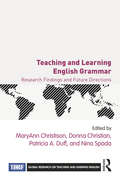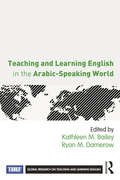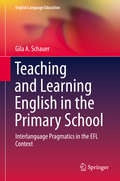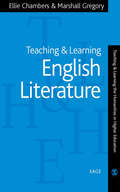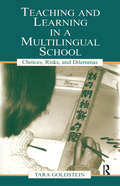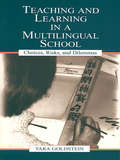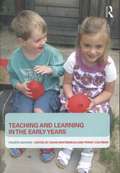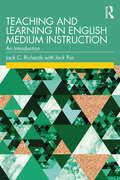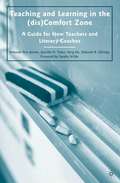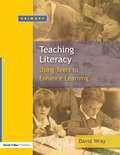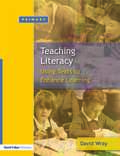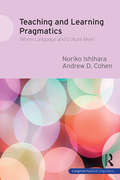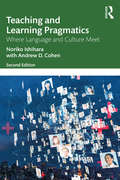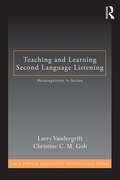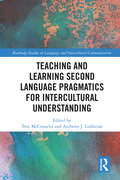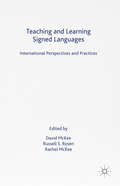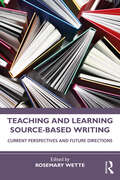- Table View
- List View
Teaching and Learning English Grammar: Research Findings and Future Directions (Global Research on Teaching and Learning English)
by Nina Spada Donna Christian Patricia A. Duff MaryAnn ChristisonAn important contribution to the emerging body of research-based knowledge about English grammar, this volume presents empirical studies along with syntheses and overviews of previous and ongoing work on the teaching and learning of grammar for learners of English as a second/foreign language. It explores a variety of approaches, including form-focused instruction, content and language integration, corpus-based lexicogrammatical approaches, and social perspectives on grammar instruction. Nine chapter authors are Priority Research Grant or Doctoral Dissertation Grant awardees from The International Research Foundation for English Language Education (TIRF), and four overview chapters are written by well-known experts in English language education. Each research chapter addresses issues that motivated the research, the context of the research, data collection and analysis, findings and discussion, and implications for practice, policy, and future research. The TIRF-sponsored research was made possible by a generous gift from Betty Azar. This book honors her contributions to the field and recognizes her generosity in collaborating with TIRF to support research on English grammar. Teaching and Learning English Grammar is the second volume in the Global Research on Teaching and Learning English Series, co-published by Routledge and TIRF.
Teaching and Learning English in the Arabic-Speaking World: Teaching And Learning English In The Arabic-speaking World (Global Research on Teaching and Learning English)
by Kathleen M. Bailey Ryan M. DamerowCo-published with The International Research Foundation for English Language Education (TIRF) An important contribution to the emerging body of research-based knowledge about teaching English to native speakers of Arabic, this volume presents empirical studies carried out in Egypt, Lebanon, Oman, Palestine, Saudi Arabia, and the United Arab Emirates (UAE)—a region which has gained notable attention in the past few decades. Each chapter addresses an issue of current concern, and each includes implications for policy, practice, and future research. Nine chapter authors are Sheikh Nahayan Fellows—recipients of doctoral fellowships from The International Research Foundation for English Language Education (TIRF). This volume is the first in the Global Research on Teaching and Learning English Series, co-published by Routledge and TIRF.
Teaching and Learning English in the Arabic-Speaking World (Global Research on Teaching and Learning English)
by Kathleen M. Bailey Ryan M. DamerowCo-published with The International Research Foundation for English Language Education (TIRF) An important contribution to the emerging body of research-based knowledge about teaching English to native speakers of Arabic, this volume presents empirical studies carried out in Egypt, Lebanon, Oman, Palestine, Saudi Arabia, and the United Arab Emirates (UAE)—a region which has gained notable attention in the past few decades. Each chapter addresses an issue of current concern, and each includes implications for policy, practice, and future research. Nine chapter authors are Sheikh Nahayan Fellows—recipients of doctoral fellowships from The International Research Foundation for English Language Education (TIRF). This volume is the first in the Global Research on Teaching and Learning English Series, co-published by Routledge and TIRF.
Teaching and Learning English in the Primary School: Interlanguage Pragmatics in the EFL Context (English Language Education #18)
by Gila A. SchauerThis book is the first comprehensive investigation of interlanguage pragmatic issues in a primary school context that is based on both primary school teachers’ statements on their own teaching realities, views and preferences, and a thorough investigation of materials used by teachers and recommended by teacher educators in the state the primary schools are located in. It offers a contrastive analysis of primary school learners acquiring English in a typical English as a foreign language school context and their age peers in the same state that are exposed to English in a school immersion context. This book will be of interest to scholars, researchers, educators in higher education that focus on English language teaching, second language acquisition and applied linguistics. It is also intended for students who are planning to become primary school teachers of English as a foreign language.
Teaching and Learning English Literature
by Dr Marshall Gregory Professor Ellie Chambers'It is scarcely possible to imagine a truly educated person who cannot read well. Yet it is not clear how or even if courses in literature actually work. How can teachers of English help students in their developmental journey toward becoming skillful readers and educated persons? This is the complex question that Chambers and Gregory address in Teaching and Learning English Literature. The authors consider practical matters such as course design and student assessment but do not shirk larger historical and theoretical issues. In a lucid and non-polemical fashion - and occasionally with welcome humor - Chambers and Gregory describe the what, why, and how of "doing" literature, often demonstrating the techniques they advocate. Veteran teachers will find the book rejuvenating, a stimulus to examining purposes and methods; beginning teachers may well find it indispensable' - Professor William Monroe, University of Houston 'The transatlantic cooperation of Ellie Chambers and Marshall Gregory has produced an outstanding book that ought to be on the shelves of anyone involved in the teaching of English Literature, as well as anyone engaged in the scholarship of teaching and learning in general or in any discipline. As they say, "the teaching of English Literature plays a central role in human beings' search for meaning" although others in other disciplines may make this claim for theirs too. If so, they will still learn a great deal from this book; anyone looking for no more than a means of satisfying the demands of governments that look for simplistic quality measures and economic relevance, let them look elsewhere. This is a book for now and for all times' - Professor Lewis Elton, Visiting Professor, University of Manchester, Honorary Professor, University College London This is the third in the series Teaching and Learning the Humanities in Higher Education. The book is for beginning and experienced teachers of literature in higher education. The authors present a comprehensive overview of teaching English literature, from setting teaching goals and syllabus-planning through to a range of student assessment strategies and methods of course or teacher evaluation and improvement. Particular attention is paid to different teaching methods, from the traditional classroom to newer collaborative work, distance education and uses of electronic technologies. All this is set in the context of present-day circumstances and agendas to help academics and those in training become more informed and better teachers of their subject. The book includes: - how literature as a discipline is currently understood and constituted - what it means to study and learn the subject - what 'good teaching' is, with fewer resources for teaching, larger student numbers, an emphasis on 'user-pay' principles and vocationalism. This is an essential text for teachers of English Literature in universities and colleges worldwide. The Teaching & Learning in the Humanities series, edited by Ellie Chambers and Jan Parker, is for beginning and experienced lecturers. It deals with all aspects of teaching individual arts and humanities subjects in higher education. Experienced teachers offer authoritative suggestions on how to become critically reflective about discipline-specific practices.
Teaching and Learning English Literature (PDF)
by Dr Marshall Gregory Professor Ellie Chambers'It is scarcely possible to imagine a truly educated person who cannot read well. Yet it is not clear how or even if courses in literature actually work. How can teachers of English help students in their developmental journey toward becoming skillful readers and educated persons? This is the complex question that Chambers and Gregory address in Teaching and Learning English Literature. The authors consider practical matters such as course design and student assessment but do not shirk larger historical and theoretical issues. In a lucid and non-polemical fashion - and occasionally with welcome humor - Chambers and Gregory describe the what, why, and how of "doing" literature, often demonstrating the techniques they advocate. Veteran teachers will find the book rejuvenating, a stimulus to examining purposes and methods; beginning teachers may well find it indispensable' - Professor William Monroe, University of Houston 'The transatlantic cooperation of Ellie Chambers and Marshall Gregory has produced an outstanding book that ought to be on the shelves of anyone involved in the teaching of English Literature, as well as anyone engaged in the scholarship of teaching and learning in general or in any discipline. As they say, "the teaching of English Literature plays a central role in human beings' search for meaning" although others in other disciplines may make this claim for theirs too. If so, they will still learn a great deal from this book; anyone looking for no more than a means of satisfying the demands of governments that look for simplistic quality measures and economic relevance, let them look elsewhere. This is a book for now and for all times' - Professor Lewis Elton, Visiting Professor, University of Manchester, Honorary Professor, University College London This is the third in the series Teaching and Learning the Humanities in Higher Education. The book is for beginning and experienced teachers of literature in higher education. The authors present a comprehensive overview of teaching English literature, from setting teaching goals and syllabus-planning through to a range of student assessment strategies and methods of course or teacher evaluation and improvement. Particular attention is paid to different teaching methods, from the traditional classroom to newer collaborative work, distance education and uses of electronic technologies. All this is set in the context of present-day circumstances and agendas to help academics and those in training become more informed and better teachers of their subject. The book includes: - how literature as a discipline is currently understood and constituted - what it means to study and learn the subject - what 'good teaching' is, with fewer resources for teaching, larger student numbers, an emphasis on 'user-pay' principles and vocationalism. This is an essential text for teachers of English Literature in universities and colleges worldwide. The Teaching & Learning in the Humanities series, edited by Ellie Chambers and Jan Parker, is for beginning and experienced lecturers. It deals with all aspects of teaching individual arts and humanities subjects in higher education. Experienced teachers offer authoritative suggestions on how to become critically reflective about discipline-specific practices.
Teaching and Learning in a Multilingual School: Choices, Risks, and Dilemmas (Language, Culture, and Teaching Series)
by Tara Goldstein Gordon Pon Timothy Chiu Judith NganTeaching and Learning in a Multilingual School: Choices, Risks, and Dilemmas is for teachers and teacher educators working in communities that educate children who do not speak English as a first language. At the center of the book are findings from a four-year critical ethnographic case study of a Canadian high school with a large number of emigrant students from Hong Kong and rich descriptions of the multitude of ways teachers and students thought about, responded to, and negotiated the issues and dilemmas that arose. The solutions and insights they derived from their experiences of working across linguistic, cultural, and racial differences will be extremely valuable to educators in other locales that have become home to large numbers of immigrant families. The book is designed to help readers think about how the issues and dilemmas in the case study manifest themselves in their own communities and how to apply the insights they gain to their own teaching and learning contexts: * Each chapter includes four components: an excerpt from the ethnographic study; an analytic commentary on the ethnographic text drawn from a variety of theoretical perspectives and academic disciplines (including interactionist sociolinguistics, language minority education, English as a Second Language education, critical literacy, anti-racist education, and critical teacher education); a pedagogical discussion; and suggestions for further reflection and discussion. * The book features the use of ethnographic play writing to engage readers with the issues that arise in multicultural/multilingual schools. The author's play Hong Kong, Canada is included in its entirety and is used to stimulate further discussion of the issues raised in each of the chapters. * Although it is organized around two different kinds of schooling dilemmas--dilemmas of speech and silence, and dilemmas of discrimination--everyday dilemmas of curriculum and assessment are also discussed throughout the book. * A methodological discussion of the choices the author made while designing, conducting, and writing up the critical ethnographic case study makes the book useful in qualitative research methodology courses. * A set of strategies and activities is provided for helping students develop English oral presentation skills.
Teaching and Learning in a Multilingual School: Choices, Risks, and Dilemmas (Language, Culture, and Teaching Series)
by Tara Goldstein Gordon Pon Timothy Chiu Judith NganTeaching and Learning in a Multilingual School: Choices, Risks, and Dilemmas is for teachers and teacher educators working in communities that educate children who do not speak English as a first language. At the center of the book are findings from a four-year critical ethnographic case study of a Canadian high school with a large number of emigrant students from Hong Kong and rich descriptions of the multitude of ways teachers and students thought about, responded to, and negotiated the issues and dilemmas that arose. The solutions and insights they derived from their experiences of working across linguistic, cultural, and racial differences will be extremely valuable to educators in other locales that have become home to large numbers of immigrant families. The book is designed to help readers think about how the issues and dilemmas in the case study manifest themselves in their own communities and how to apply the insights they gain to their own teaching and learning contexts: * Each chapter includes four components: an excerpt from the ethnographic study; an analytic commentary on the ethnographic text drawn from a variety of theoretical perspectives and academic disciplines (including interactionist sociolinguistics, language minority education, English as a Second Language education, critical literacy, anti-racist education, and critical teacher education); a pedagogical discussion; and suggestions for further reflection and discussion. * The book features the use of ethnographic play writing to engage readers with the issues that arise in multicultural/multilingual schools. The author's play Hong Kong, Canada is included in its entirety and is used to stimulate further discussion of the issues raised in each of the chapters. * Although it is organized around two different kinds of schooling dilemmas--dilemmas of speech and silence, and dilemmas of discrimination--everyday dilemmas of curriculum and assessment are also discussed throughout the book. * A methodological discussion of the choices the author made while designing, conducting, and writing up the critical ethnographic case study makes the book useful in qualitative research methodology courses. * A set of strategies and activities is provided for helping students develop English oral presentation skills.
Teaching And Learning In The Early Years (PDF)
by David Whitebread Penelope Coltman Penny ColtmanThis best-selling text book provides a broad-ranging and up-to-date review of thinking and best practice within nursery and infant education. Written around the basic truth that an effective early years curriculum must start with the children, their needs and their potential, the contributors to this classic text acknowledge that learning must have a strong element of fun, wonder and excitement. Fully revised and updated in light of recent changes to the Early Years curriculum, with brand new chapters on assessment, communication, writing, creativity and diversity, the contributors address a range of fundamental issues and principles, including: an analysis of research into how children learn; discussions of issues such as classroom organisation, curriculum management, and assessment; a detailed section on play and language; chapters covering individual curriculum areas, including new chapters on music and PSHE. Each chapter combines a review of important principles with practical and inspiring classroom examples throughout. It is essential reading for all Foundations Stage and KS1 trainee teachers, their tutors and mentors, and serving teachers working in the 3-7 age range who wish to reflect upon and develop their practice.
Teaching and Learning in English Medium Instruction: An Introduction
by Jack C. Richards Jack PunTeaching and Learning in English Medium Instruction provides an overview of the nature of English Medium Instruction (EMI) in both secondary and tertiary education. The book explores the nature of academic literacy in EMI the ways in which EMI is implemented in different contexts issues related to teaching and learning through the medium of English teaching challenges and coping strategies used by EMI teachers support for EMI through EAP the professional development needs of EMI teachers approaches to the evaluation of EMI programs. The book contains a number of short chapters written in an accessible style with discussion questions and practical follow-up tasks. Throughout the book, key theory and research serve to introduce the core issues involved in EMI, which are then explored in terms of implications for practice. The book can be used in workshops and courses and for groups that include EMI teachers of content subjects, EAP teachers, TESOL students, and teachers and education officials involved with the implementation of EMI in different contexts. With the expansion of EMI worldwide in recent years the book seeks to introduce EMI to a new generation of EMI teachers and language teaching professionals.
Teaching and Learning in English Medium Instruction: An Introduction
by Jack C. Richards Jack PunTeaching and Learning in English Medium Instruction provides an overview of the nature of English Medium Instruction (EMI) in both secondary and tertiary education. The book explores the nature of academic literacy in EMI the ways in which EMI is implemented in different contexts issues related to teaching and learning through the medium of English teaching challenges and coping strategies used by EMI teachers support for EMI through EAP the professional development needs of EMI teachers approaches to the evaluation of EMI programs. The book contains a number of short chapters written in an accessible style with discussion questions and practical follow-up tasks. Throughout the book, key theory and research serve to introduce the core issues involved in EMI, which are then explored in terms of implications for practice. The book can be used in workshops and courses and for groups that include EMI teachers of content subjects, EAP teachers, TESOL students, and teachers and education officials involved with the implementation of EMI in different contexts. With the expansion of EMI worldwide in recent years the book seeks to introduce EMI to a new generation of EMI teachers and language teaching professionals.
Teaching and Learning in the (dis)Comfort Zone: A Guide for New Teachers and Literacy Coaches
by D. Jensen D. Eldridge Y. Hu J. TutenThe novice teacher and literacy coach need to form a team to share their expertise and continually evolve, to have opportunity for guided reflection and self-assessment of practice. This book shares these professional experiences which delineates and describes the (dis)comfort of teaching and learning at the edge of the teachers' comfort zone.
Teaching and Learning Literacy: Reading and Writing Texts for a Purpose
by David WrayDavid Wray offers a range of practical suggestions for enhancing literacy work in primary and secondary schools (KS 1-3). The book is based on the idea that the purpose of literacy teaching is to enable pupils to understand and create meaningful, whole texts. It deliberately takes a cross-curricular view of literacy and will appeal to teachers who specialize in a range of subjects. It also explores in-depth the processes involved in both understanding and composing a range of text types, avoiding the temptation to segment literacy skills, thereby losing sight of the overall purpose. The book is aimed at primary teachers and student teachers with an interest in extending their pupils' experiences of texts across the curriculum; and at secondary teachers (especially English teachers) who wish to include in their subject teaching more explicit attention to their pupils' literacy skills.
Teaching and Learning Literacy: Reading and Writing Texts for a Purpose
by David WrayDavid Wray offers a range of practical suggestions for enhancing literacy work in primary and secondary schools (KS 1-3). The book is based on the idea that the purpose of literacy teaching is to enable pupils to understand and create meaningful, whole texts. It deliberately takes a cross-curricular view of literacy and will appeal to teachers who specialize in a range of subjects. It also explores in-depth the processes involved in both understanding and composing a range of text types, avoiding the temptation to segment literacy skills, thereby losing sight of the overall purpose. The book is aimed at primary teachers and student teachers with an interest in extending their pupils' experiences of texts across the curriculum; and at secondary teachers (especially English teachers) who wish to include in their subject teaching more explicit attention to their pupils' literacy skills.
Teaching and Learning Pragmatics: Where Language and Culture Meet
by Noriko Ishihara Andrew D. CohenAn understanding of sociocultural context is crucial in second language learning - yet developing this awareness often poses a real challenge to the typical language learner. This book is a practical language teachers' guide that focuses on how to teach socially and culturally appropriate language for effective communication. Moving beyond a purely theoretical approach to pragmatics, the volume offers practical advice to teachers, with hands-on classroom tasks included in every chapter. Readers will be able to: · Identify possible causes of learner errors and choices in cross-cultural communication· Understand second language acquisition theories that support their classroom practices· Develop a pragmatics-focused instructional component, classroom-based assessments, and curricula · Help learners to become more strategic about their learning and performance of speech acts· Incorporate technology into their approach to teaching pragmaticsThis book aims to close the gap between what research in pragmatics has found and how language is generally taught today. It will be of interest to all language teachers, graduate students in language teaching and linguistics, teacher educators, and developers of materials for teaching language.
Teaching and Learning Pragmatics: Where Language and Culture Meet
by Noriko Ishihara Andrew D. CohenAn understanding of sociocultural context is crucial in second language learning - yet developing this awareness often poses a real challenge to the typical language learner. This book is a practical language teachers' guide that focuses on how to teach socially and culturally appropriate language for effective communication. Moving beyond a purely theoretical approach to pragmatics, the volume offers practical advice to teachers, with hands-on classroom tasks included in every chapter. Readers will be able to: · Identify possible causes of learner errors and choices in cross-cultural communication· Understand second language acquisition theories that support their classroom practices· Develop a pragmatics-focused instructional component, classroom-based assessments, and curricula · Help learners to become more strategic about their learning and performance of speech acts· Incorporate technology into their approach to teaching pragmaticsThis book aims to close the gap between what research in pragmatics has found and how language is generally taught today. It will be of interest to all language teachers, graduate students in language teaching and linguistics, teacher educators, and developers of materials for teaching language.
Teaching and Learning Pragmatics: Where Language and Culture Meet
by Noriko Ishihara Andrew D. CohenAn understanding of sociocultural context is crucial in second language learning–yet developing this awareness often poses a real challenge to the typical language learner. This book is a language teachers’ guide that focuses on how to teach socially and culturally preferred language for effective intercultural communication. Moving beyond a purely theoretical approach to pragmatics, the volume offers practical advice to teachers, with hands-on classroom tasks included in every chapter. Readers will be able to: · Understand the link between language use, linguacultural diversity, and multilingual identity · Identify possible causes of learner errors and choices in intercultural communication · Understand applied linguistics theories that support culturally sensitive classroom practices · Develop a pragmatics-focused instructional component, classroom-based assessments, and curricula · Help learners to become more strategic about their learning and performance of speech acts · Incorporate technology into their approach to teaching pragmatics This book aims to close the gap between what research in pragmatics has found and how language is generally taught today. It will be of interest to all language teachers, graduate students in language teaching and linguistics, teacher educators, and developers of materials for teaching language.
Teaching and Learning Pragmatics: Where Language and Culture Meet
by Noriko Ishihara Andrew D. CohenAn understanding of sociocultural context is crucial in second language learning–yet developing this awareness often poses a real challenge to the typical language learner. This book is a language teachers’ guide that focuses on how to teach socially and culturally preferred language for effective intercultural communication. Moving beyond a purely theoretical approach to pragmatics, the volume offers practical advice to teachers, with hands-on classroom tasks included in every chapter. Readers will be able to: · Understand the link between language use, linguacultural diversity, and multilingual identity · Identify possible causes of learner errors and choices in intercultural communication · Understand applied linguistics theories that support culturally sensitive classroom practices · Develop a pragmatics-focused instructional component, classroom-based assessments, and curricula · Help learners to become more strategic about their learning and performance of speech acts · Incorporate technology into their approach to teaching pragmatics This book aims to close the gap between what research in pragmatics has found and how language is generally taught today. It will be of interest to all language teachers, graduate students in language teaching and linguistics, teacher educators, and developers of materials for teaching language.
Teaching and Learning Second Language Listening: Metacognition in Action (ESL & Applied Linguistics Professional Series)
by Larry Vandergrift Christine C.M. GohThis reader-friendly text, firmly grounded in listening theories and supported by recent research findings, offers a comprehensive treatment of concepts and knowledge related to teaching second language (L2) listening, with a particular emphasis on metacognition. The metacognitive approach, aimed at developing learner listening in a holistic manner, is unique and groundbreaking. The book is focused on the language learner throughout; all theoretical perspectives, research insights, and pedagogical principles in the book are presented and discussed in relation to the learner. The pedagogical model?a combination of the tried-and-tested sequence of listening lessons and activities that show learners how to activate processes of skilled listeners ? provides teachers with a sound framework for students’ L2 listening development to take place inside and outside the classroom. The text includes many practical ideas for listening tasks that have been used successfully in various language learning contexts.
Teaching and Learning Second Language Listening: Metacognition in Action (ESL & Applied Linguistics Professional Series)
by Larry Vandergrift Christine C.M. GohThis reader-friendly text, firmly grounded in listening theories and supported by recent research findings, offers a comprehensive treatment of concepts and knowledge related to teaching second language (L2) listening, with a particular emphasis on metacognition. The metacognitive approach, aimed at developing learner listening in a holistic manner, is unique and groundbreaking. The book is focused on the language learner throughout; all theoretical perspectives, research insights, and pedagogical principles in the book are presented and discussed in relation to the learner. The pedagogical model─a combination of the tried-and-tested sequence of listening lessons and activities that show learners how to activate processes of skilled listeners ─ provides teachers with a sound framework for students’ L2 listening development to take place inside and outside the classroom. The text includes many practical ideas for listening tasks that have been used successfully in various language learning contexts.
Teaching and Learning Second Language Pragmatics for Intercultural Understanding (Routledge Studies in Language and Intercultural Communication)
by Troy McConachy Anthony J. LiddicoatThis collection argues for the need to promote intercultural understanding as a clear goal for teaching and learning pragmatics in second and foreign language education. The volume sees the learning of pragmatics as a challenging yet enriching process whereby the individual expands their capacity for understanding how meaning making processes influence social relationships and how assumptions about social relationships shape the interpretation and use of language in context. This locates pragmatics within a humanistically oriented conception of learning where success is defined relative to the enrichment of human understanding and appreciation of difference. The book argues that intercultural understanding is not an “add on” to language learning but central to the learner’s ability to understand and construct meaning with individuals from diverse linguistic and cultural backgrounds. Chapters analyse teachers’ and learners’ ways of making sense of pragmatics, how their assumptions about social relationships impact their perceptions of language use, and how reflection on pragmatic judgments opens up possibilities for developing intercultural understanding. This book will be of interest to students and scholars in intercultural communication, language education, and applied linguistics.
Teaching and Learning Second Language Pragmatics for Intercultural Understanding (Routledge Studies in Language and Intercultural Communication)
by Troy McConachy Anthony J. LiddicoatThis collection argues for the need to promote intercultural understanding as a clear goal for teaching and learning pragmatics in second and foreign language education. The volume sees the learning of pragmatics as a challenging yet enriching process whereby the individual expands their capacity for understanding how meaning making processes influence social relationships and how assumptions about social relationships shape the interpretation and use of language in context. This locates pragmatics within a humanistically oriented conception of learning where success is defined relative to the enrichment of human understanding and appreciation of difference. The book argues that intercultural understanding is not an “add on” to language learning but central to the learner’s ability to understand and construct meaning with individuals from diverse linguistic and cultural backgrounds. Chapters analyse teachers’ and learners’ ways of making sense of pragmatics, how their assumptions about social relationships impact their perceptions of language use, and how reflection on pragmatic judgments opens up possibilities for developing intercultural understanding. This book will be of interest to students and scholars in intercultural communication, language education, and applied linguistics.
Teaching and Learning Signed Languages: International Perspectives and Practices
by Russell S. Rosen David McKee Rachel McKeeTeaching and Learning Signed Languages examines current practices, contexts, and the research nexus in the teaching and learning of signed languages, offering a contemporary, international survey of innovations in this field.
Teaching and Learning Source-Based Writing: Current Perspectives and Future Directions
by Rosemary WetteThis volume brings together significant findings, approaches, and research-based pedagogies on teaching and learning source-based writing. A comprehensive update to the field, this book presents source-based writing as an essential skill that comes with its own specific set of challenges, requiring a complex set of literacy skills and capabilities for mastery. With contributors from leading scholars from around the world, the volume addresses source-based writing as a developmental issue and offers guidance for supporting novice academic writers on their path toward proficiency and accumulation of multifaceted skill set. Chapters cover key topics, including metacognitive skills, the flipped classroom, scaffolding, assessment, and ethical considerations. With research reviews, practical considerations and future directions as components of each chapter, this book is ideal for courses on academic writing and second language writing.
Teaching and Learning Source-Based Writing: Current Perspectives and Future Directions
This volume brings together significant findings, approaches, and research-based pedagogies on teaching and learning source-based writing. A comprehensive update to the field, this book presents source-based writing as an essential skill that comes with its own specific set of challenges, requiring a complex set of literacy skills and capabilities for mastery. With contributors from leading scholars from around the world, the volume addresses source-based writing as a developmental issue and offers guidance for supporting novice academic writers on their path toward proficiency and accumulation of multifaceted skill set. Chapters cover key topics, including metacognitive skills, the flipped classroom, scaffolding, assessment, and ethical considerations. With research reviews, practical considerations and future directions as components of each chapter, this book is ideal for courses on academic writing and second language writing.
